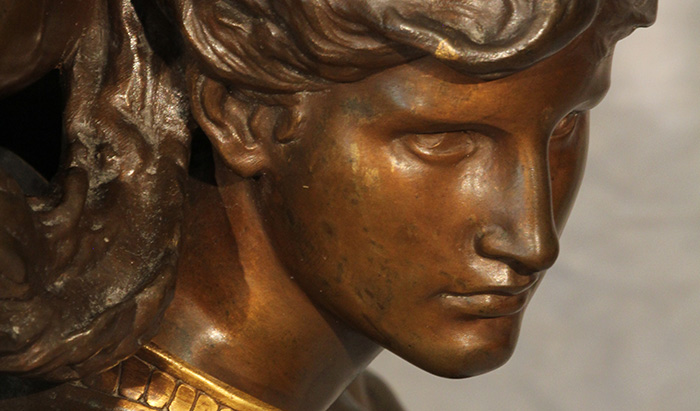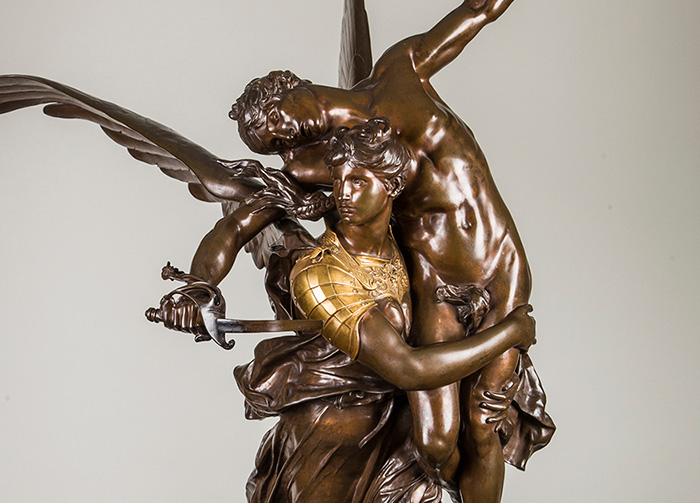Restoring Glory

Exhibition highlights art-conservation project
by MaryAlice Bitts-Jackson
The Trout Gallery's Gloria Victis is a magnificent, allegorical statue that was long cherished by a former Dickinson professor. And during the Friday, Jan. 29 opening reception to a current Trout Gallery exhibition, you can see this 19th-century bronze at its gleaming best, thanks to a 2015 graduate who merged what she learned in chemistry and art courses to help restore it to its former glory.
A postwar sensation
The statue, which depicts a fallen soldier held aloft by a winged creature, is a sensitive tribute to those fallen in combat after France's defeat in the Franco-Prussian war.
It was created by Marius-Jean-Antonin Mercié, a native of Toulouse, France, and an Ecole des Beaux-Arts grad who attracted most of the major institutional and universal exposition awards of his time. His work includes celebrated Salon paintings; decoration for the tombs of some of the most prominent figures of his century; a bronze relief for the Louvre façade and a gilt-bronze figure for the Tracadero Palace dome; statues and memorials, including a figure of Joan of Arc, displayed at her home; the French David, which garnered the Legion of Honor; and the roughly 10-foot Gloria Victis, designed c. 1874.
“Mercié was already well-known by the time he created Gloria Victis, and it was a sensation from the start,” says Phillip Earenfight, associate professor of art & art history and director of The Trout Gallery. “Paris’ finest metalcasters used the plaster to cast reductions of various sizes soon after the work was unveiled.”
And as those high-quality reductions were released on the market, collectors scrambled to place one in their homes.
One of the bronzes belonged to Harry Booth, professor emeritus of religion (Ganoe Award recipient, 1970-71), whose father had purchased Mercié’s “Tribute to the Fallen” in Europe, after losing a son to combat during World War II. Decades later, Booth donated the bronze statue to The Trout Gallery, and it is now part of the college’s permanent art collection.
Like many works, it needed some TLC to become exhibition-ready. That created a perfect senior project for Meghan Abercrombie ’15.
‘A very rare opportunity’

An art & art history major who came to Dickinson with an interest in art conservation, Abercrombie augmented her liberal-arts, studio-art and art-history courses with additional coursework in chemistry to prepare for a career in the field. She also assisted with conservation work as a study-abroad student in Florence, Italy—an excellent prelude to this more intensive project.
With help from Earenfight, Abercrombie connected with art conservators Brian Howard and April Berry. And under their direction, she jumped in.
Using magnifiers, a stereoscope and X-ray fluorescence to determine the composition and condition of the metal, Abercrombie learned that while the statue was in stable condition, a few areas were slightly bent as if by a fall. The patina on the statue’s surface, meanwhile, was thin and fragile, having been lightly corroded in some areas and worn away in others, and a varnish had been applied at some point. Wax buildup coated the base of the statue.
Working throughout the spring semester and during the summer after graduation, Abercrombie painstakingly cleaned the bronze with cotton swabs and then used a sharpened bone folder to scrape away waxy residue spots—a tedious process that took most of her time in the studio. After carefully re-washing the surface, Abercrombie applied a thin, even coat of acrylic-paint-tinted wax, which helped unify the look of the patina and protect the surface of the statue from dirt. She also used cotton swabs, soaked in mineral spirits, to clean the gilt.
Then came the tough question: Should the conservators straighten the bent wing and sword and risk damaging the fragile patina? “Half of the project was deciding what should not be done, and it was a part of the conservation process I had not previously experienced,” says Abercrombie. In the end, the team decided to let it be.
Finally, Abercrombie documented the process in writing—explaining not just what she did, but why. It was an invaluable experience for an aspiring art conservator, as she applies to graduate schools, says Earenfight, who includes excerpts from Abercrombie’s report in The Trout Gallery’s Gloria Victis exhibition catalog.
“Conservation work, particularly at this level, is a very rare opportunity for a student at the undergraduate level,” he added, “and we’re excited to highlight the work Meghan has done.”
Gloria Victis will be on display at The Trout Gallery through April 9, along with a variety Japanese and Chinese prints and photographs, selected by art-history students last spring. The opening reception is Friday, Jan. 29, at The Trout Gallery (5-7 p.m.).
Learn more
Published January 28, 2016